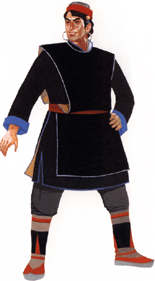| |
Their diets also differ from place to place. Some eat corn and rice while others have buckwheat, wheat, and highland barley. They like to add pepper to their food. Most of their cookware are made of stones because they think food prepared in them is tastier.
The Moinbas' customs are strongly influenced by the Tibetans. For example, like Tibetans, they like to wear pulu clothes made of woven wool.
In Monyu, men often wear pulu robes or crimson-cloth robe. Women often wear multicolored pullovers under red or black coats made of pulu, and which are used to pad a piece of sheepskin or calfskin to the backs. They often wear stringed ornaments made ofred coral, agate, and other stones. They hang a metal box with Buddhist images or scriptures inside around the neck. It is called Ga'u meaning "blessing and fortune." Both men and women wear a two-meter-long, six-meter-wide red pulu belt round their waists.
In the Metog area, when it is warm, women like to wear thin white-colored little garments or vests to go with colored skirts. Matching all these with necklaces and earrings, they look very graceful.
The Moinbas are widely famous for their household handicraft industry. Their workmanship in making wooden bowls and weaving bamboo utensils is ever flourishing. To make wooden bowls, they have to first choose the right materials: roots of hard trees such as azalea trees, or trunks or knots of tung and birch trees. Then they have to cut, whittle, and scrape them into the shape of bowls. An exquisite wooden bowl can be produced only after five or six processes. Because these bowls are beautifully patterned, durable, and easy to carry, they are greatly treasured by Tibetans and Lhobas living nearby.

Monyu, also called "Highland Jiangnan (the Southern Valley of the Changjiang River)," is picturesque with evergreens in all seasons. It has attracted worldwide attention because the sixth Dalai Lama, a great romantic poet, was brought up here. People say that A Collection of Love Songs by Cangyangjiaco, now translated into many languages, was born out of Moinba folksongs. His works retain many of the meters and styles of the Moinba love songs.
In Monyu, men and women are free to make friends with each other, and love songs have naturally become a link between young hearts. They have composed countless love songs all through the centuries.
Love and marriage between Moinbas are quite free, too. They marry on the basis of true love and their marriages are generally not affected by wealth or rank. An ancient custom, "Uncle on the mother's side raising hell at the wedding," still exists as part of their folkway, though no uncle today stands in the way of his niece's marriage. The uncle, putting on a peremptory yet humorous show, actually adds even more fun to the wedding ceremony.
The Moinbas enjoy toast songs, just as they enjoy love songs. The toasts are lively and amusing, and their tunes are merry and high. Like springs, they are sung with deep feelings. Singing with a deep love for their own lives, the Moinba people are working together with other nationalities for an even brighter future.
|
|
